Critical Evaluation of Management Accounting for NCC Group PLC
VerifiedAdded on 2020/07/23
|10
|2746
|37
Report
AI Summary
This report provides a comprehensive analysis of management accounting, focusing on its application within NCC Group PLC. It begins by defining management accounting and highlighting its importance in cost control and decision-making. The report then explores a range of management accounting techniques, including financial planning, financial statement analysis, historical cost accounting, standard costing, budgetary control, marginal costing, fund flow statements, and cash flow statements. Each technique is critically evaluated for its suitability to NCC Group, with a particular emphasis on the Activity-Based Costing (ABC) technique, discussing its advantages and disadvantages. The report further delves into the technical procedures used in management accounting, including a detailed example comparing traditional and ABC costing methods for two products, Abta and Bapta. Finally, the report concludes with an assessment of the executability of the ABC technique for NCC Ltd, comparing its results with traditional costing methods.

MANAGEMENT
ACCOUNTING
ACCOUNTING
Secure Best Marks with AI Grader
Need help grading? Try our AI Grader for instant feedback on your assignments.
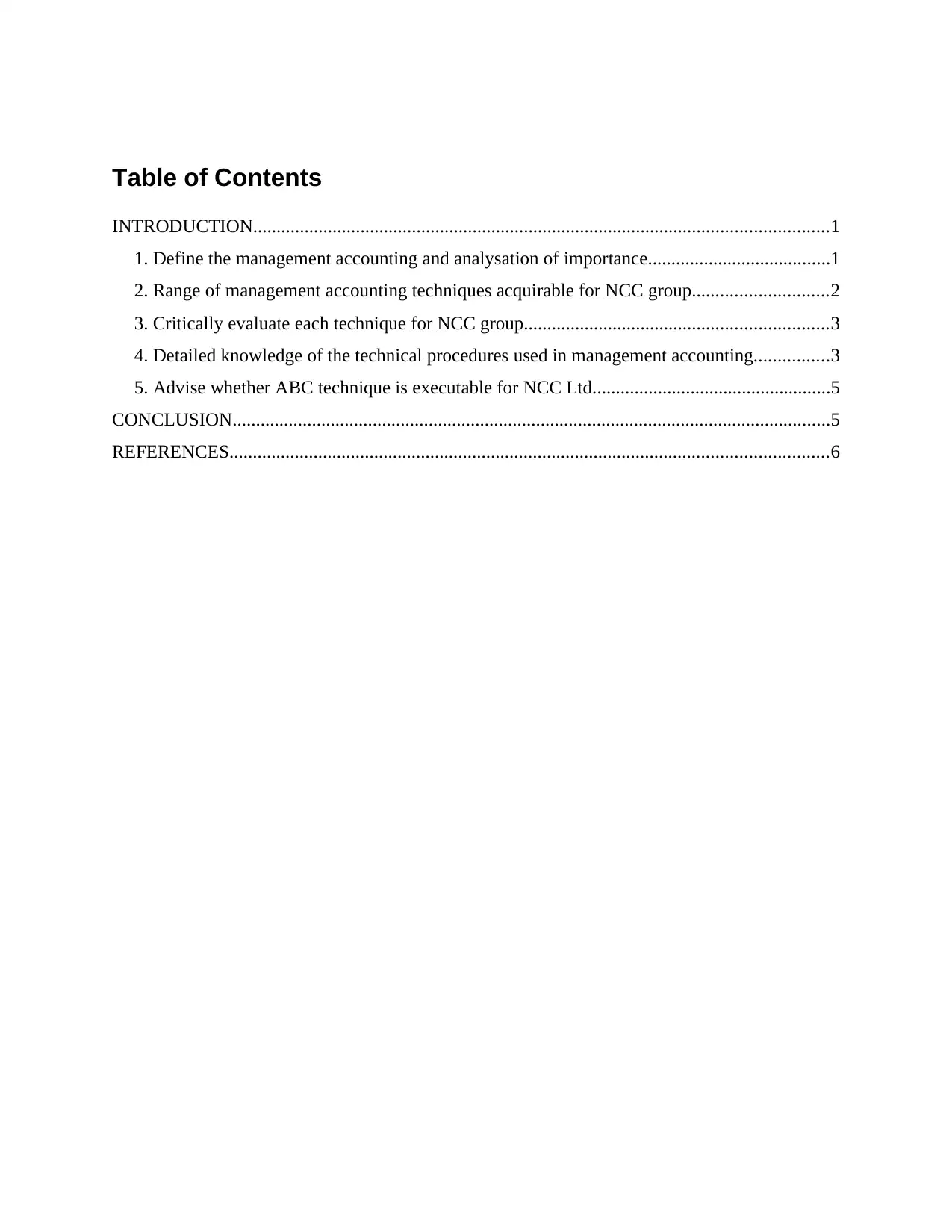
Table of Contents
INTRODUCTION...........................................................................................................................1
1. Define the management accounting and analysation of importance.......................................1
2. Range of management accounting techniques acquirable for NCC group.............................2
3. Critically evaluate each technique for NCC group.................................................................3
4. Detailed knowledge of the technical procedures used in management accounting................3
5. Advise whether ABC technique is executable for NCC Ltd...................................................5
CONCLUSION................................................................................................................................5
REFERENCES................................................................................................................................6
INTRODUCTION...........................................................................................................................1
1. Define the management accounting and analysation of importance.......................................1
2. Range of management accounting techniques acquirable for NCC group.............................2
3. Critically evaluate each technique for NCC group.................................................................3
4. Detailed knowledge of the technical procedures used in management accounting................3
5. Advise whether ABC technique is executable for NCC Ltd...................................................5
CONCLUSION................................................................................................................................5
REFERENCES................................................................................................................................6
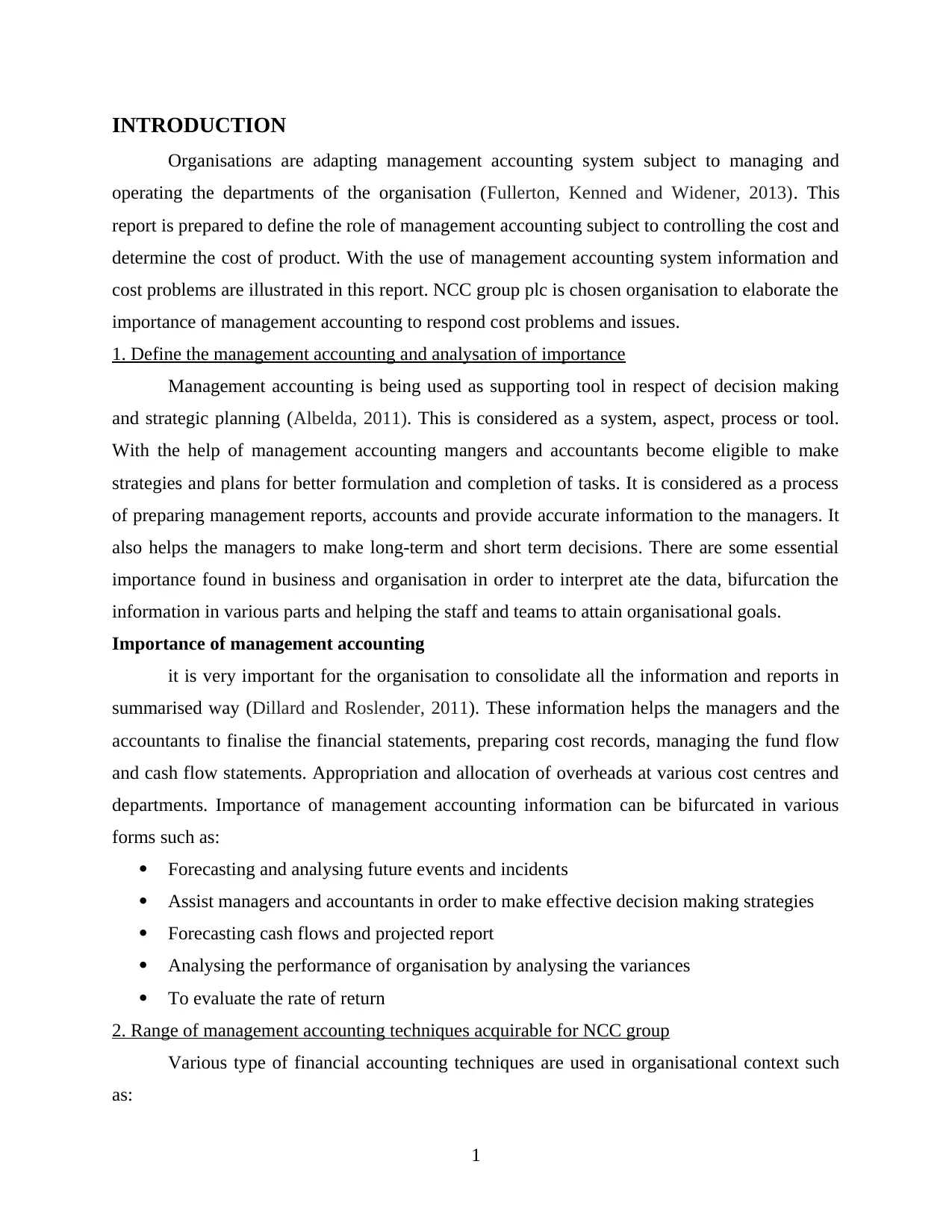
INTRODUCTION
Organisations are adapting management accounting system subject to managing and
operating the departments of the organisation (Fullerton, Kenned and Widener, 2013). This
report is prepared to define the role of management accounting subject to controlling the cost and
determine the cost of product. With the use of management accounting system information and
cost problems are illustrated in this report. NCC group plc is chosen organisation to elaborate the
importance of management accounting to respond cost problems and issues.
1. Define the management accounting and analysation of importance
Management accounting is being used as supporting tool in respect of decision making
and strategic planning (Albelda, 2011). This is considered as a system, aspect, process or tool.
With the help of management accounting mangers and accountants become eligible to make
strategies and plans for better formulation and completion of tasks. It is considered as a process
of preparing management reports, accounts and provide accurate information to the managers. It
also helps the managers to make long-term and short term decisions. There are some essential
importance found in business and organisation in order to interpret ate the data, bifurcation the
information in various parts and helping the staff and teams to attain organisational goals.
Importance of management accounting
it is very important for the organisation to consolidate all the information and reports in
summarised way (Dillard and Roslender, 2011). These information helps the managers and the
accountants to finalise the financial statements, preparing cost records, managing the fund flow
and cash flow statements. Appropriation and allocation of overheads at various cost centres and
departments. Importance of management accounting information can be bifurcated in various
forms such as:
Forecasting and analysing future events and incidents
Assist managers and accountants in order to make effective decision making strategies
Forecasting cash flows and projected report
Analysing the performance of organisation by analysing the variances
To evaluate the rate of return
2. Range of management accounting techniques acquirable for NCC group
Various type of financial accounting techniques are used in organisational context such
as:
1
Organisations are adapting management accounting system subject to managing and
operating the departments of the organisation (Fullerton, Kenned and Widener, 2013). This
report is prepared to define the role of management accounting subject to controlling the cost and
determine the cost of product. With the use of management accounting system information and
cost problems are illustrated in this report. NCC group plc is chosen organisation to elaborate the
importance of management accounting to respond cost problems and issues.
1. Define the management accounting and analysation of importance
Management accounting is being used as supporting tool in respect of decision making
and strategic planning (Albelda, 2011). This is considered as a system, aspect, process or tool.
With the help of management accounting mangers and accountants become eligible to make
strategies and plans for better formulation and completion of tasks. It is considered as a process
of preparing management reports, accounts and provide accurate information to the managers. It
also helps the managers to make long-term and short term decisions. There are some essential
importance found in business and organisation in order to interpret ate the data, bifurcation the
information in various parts and helping the staff and teams to attain organisational goals.
Importance of management accounting
it is very important for the organisation to consolidate all the information and reports in
summarised way (Dillard and Roslender, 2011). These information helps the managers and the
accountants to finalise the financial statements, preparing cost records, managing the fund flow
and cash flow statements. Appropriation and allocation of overheads at various cost centres and
departments. Importance of management accounting information can be bifurcated in various
forms such as:
Forecasting and analysing future events and incidents
Assist managers and accountants in order to make effective decision making strategies
Forecasting cash flows and projected report
Analysing the performance of organisation by analysing the variances
To evaluate the rate of return
2. Range of management accounting techniques acquirable for NCC group
Various type of financial accounting techniques are used in organisational context such
as:
1
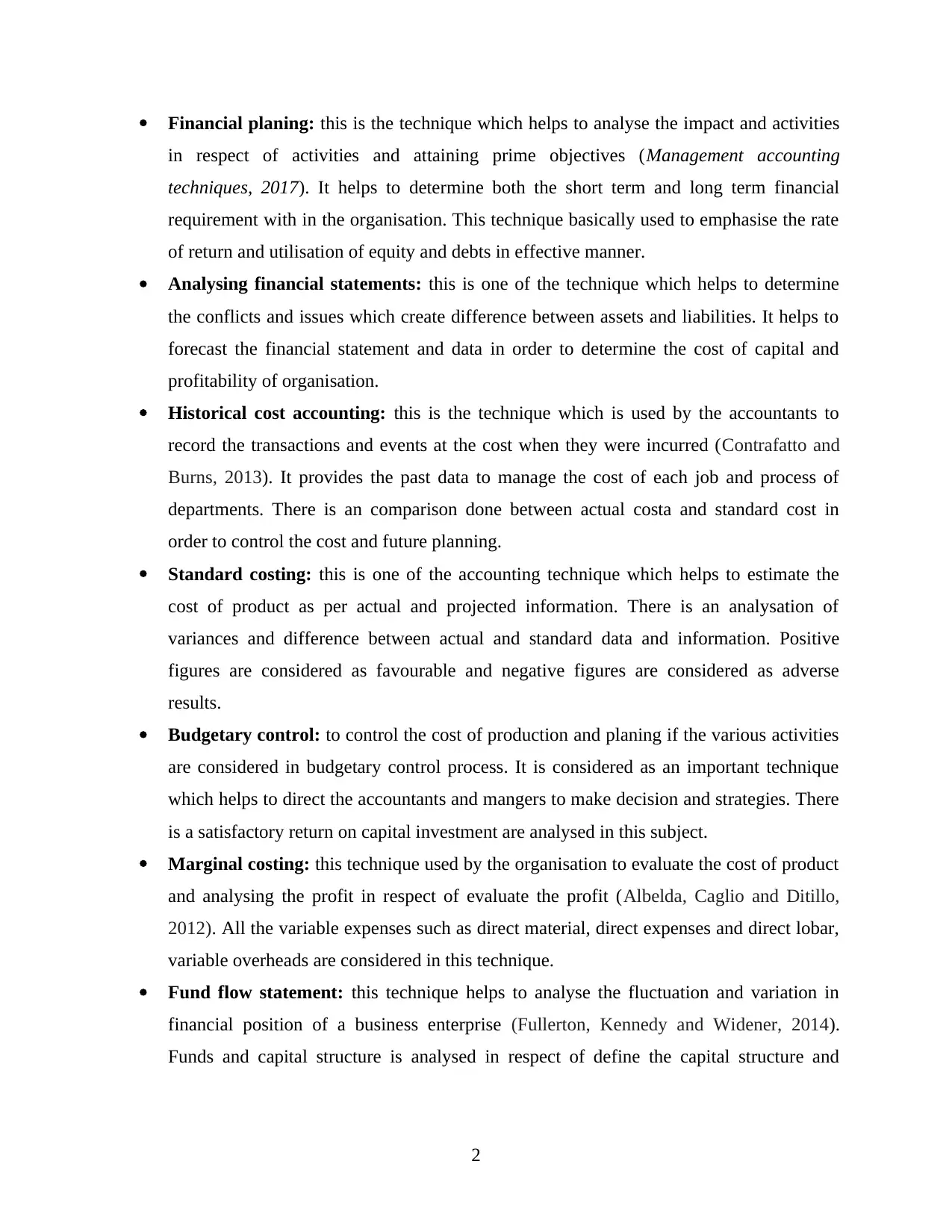
Financial planing: this is the technique which helps to analyse the impact and activities
in respect of activities and attaining prime objectives (Management accounting
techniques, 2017). It helps to determine both the short term and long term financial
requirement with in the organisation. This technique basically used to emphasise the rate
of return and utilisation of equity and debts in effective manner.
Analysing financial statements: this is one of the technique which helps to determine
the conflicts and issues which create difference between assets and liabilities. It helps to
forecast the financial statement and data in order to determine the cost of capital and
profitability of organisation.
Historical cost accounting: this is the technique which is used by the accountants to
record the transactions and events at the cost when they were incurred (Contrafatto and
Burns, 2013). It provides the past data to manage the cost of each job and process of
departments. There is an comparison done between actual costa and standard cost in
order to control the cost and future planning.
Standard costing: this is one of the accounting technique which helps to estimate the
cost of product as per actual and projected information. There is an analysation of
variances and difference between actual and standard data and information. Positive
figures are considered as favourable and negative figures are considered as adverse
results.
Budgetary control: to control the cost of production and planing if the various activities
are considered in budgetary control process. It is considered as an important technique
which helps to direct the accountants and mangers to make decision and strategies. There
is a satisfactory return on capital investment are analysed in this subject.
Marginal costing: this technique used by the organisation to evaluate the cost of product
and analysing the profit in respect of evaluate the profit (Albelda, Caglio and Ditillo,
2012). All the variable expenses such as direct material, direct expenses and direct lobar,
variable overheads are considered in this technique.
Fund flow statement: this technique helps to analyse the fluctuation and variation in
financial position of a business enterprise (Fullerton, Kennedy and Widener, 2014).
Funds and capital structure is analysed in respect of define the capital structure and
2
in respect of activities and attaining prime objectives (Management accounting
techniques, 2017). It helps to determine both the short term and long term financial
requirement with in the organisation. This technique basically used to emphasise the rate
of return and utilisation of equity and debts in effective manner.
Analysing financial statements: this is one of the technique which helps to determine
the conflicts and issues which create difference between assets and liabilities. It helps to
forecast the financial statement and data in order to determine the cost of capital and
profitability of organisation.
Historical cost accounting: this is the technique which is used by the accountants to
record the transactions and events at the cost when they were incurred (Contrafatto and
Burns, 2013). It provides the past data to manage the cost of each job and process of
departments. There is an comparison done between actual costa and standard cost in
order to control the cost and future planning.
Standard costing: this is one of the accounting technique which helps to estimate the
cost of product as per actual and projected information. There is an analysation of
variances and difference between actual and standard data and information. Positive
figures are considered as favourable and negative figures are considered as adverse
results.
Budgetary control: to control the cost of production and planing if the various activities
are considered in budgetary control process. It is considered as an important technique
which helps to direct the accountants and mangers to make decision and strategies. There
is a satisfactory return on capital investment are analysed in this subject.
Marginal costing: this technique used by the organisation to evaluate the cost of product
and analysing the profit in respect of evaluate the profit (Albelda, Caglio and Ditillo,
2012). All the variable expenses such as direct material, direct expenses and direct lobar,
variable overheads are considered in this technique.
Fund flow statement: this technique helps to analyse the fluctuation and variation in
financial position of a business enterprise (Fullerton, Kennedy and Widener, 2014).
Funds and capital structure is analysed in respect of define the capital structure and
2
Secure Best Marks with AI Grader
Need help grading? Try our AI Grader for instant feedback on your assignments.
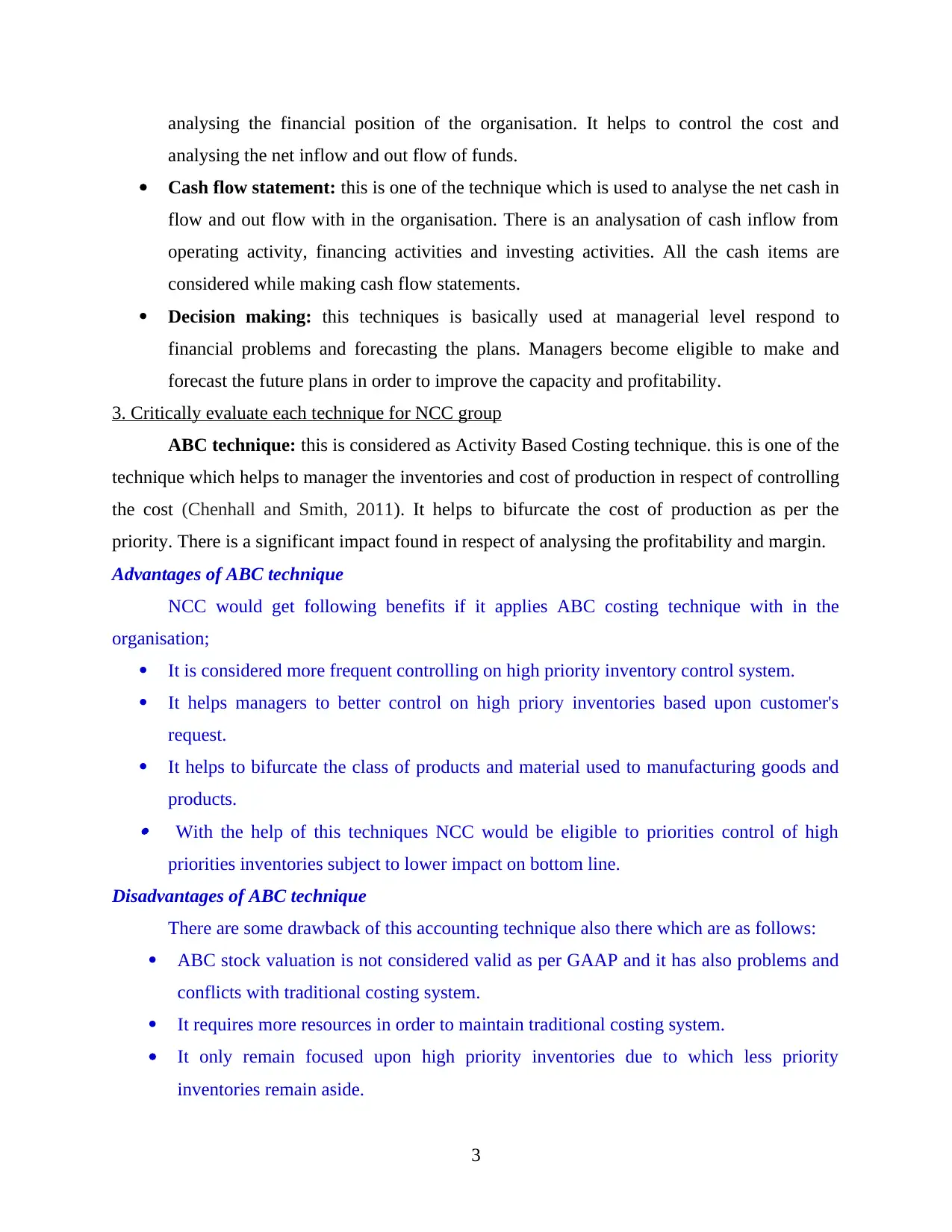
analysing the financial position of the organisation. It helps to control the cost and
analysing the net inflow and out flow of funds.
Cash flow statement: this is one of the technique which is used to analyse the net cash in
flow and out flow with in the organisation. There is an analysation of cash inflow from
operating activity, financing activities and investing activities. All the cash items are
considered while making cash flow statements.
Decision making: this techniques is basically used at managerial level respond to
financial problems and forecasting the plans. Managers become eligible to make and
forecast the future plans in order to improve the capacity and profitability.
3. Critically evaluate each technique for NCC group
ABC technique: this is considered as Activity Based Costing technique. this is one of the
technique which helps to manager the inventories and cost of production in respect of controlling
the cost (Chenhall and Smith, 2011). It helps to bifurcate the cost of production as per the
priority. There is a significant impact found in respect of analysing the profitability and margin.
Advantages of ABC technique
NCC would get following benefits if it applies ABC costing technique with in the
organisation;
It is considered more frequent controlling on high priority inventory control system.
It helps managers to better control on high priory inventories based upon customer's
request.
It helps to bifurcate the class of products and material used to manufacturing goods and
products. With the help of this techniques NCC would be eligible to priorities control of high
priorities inventories subject to lower impact on bottom line.
Disadvantages of ABC technique
There are some drawback of this accounting technique also there which are as follows:
ABC stock valuation is not considered valid as per GAAP and it has also problems and
conflicts with traditional costing system.
It requires more resources in order to maintain traditional costing system.
It only remain focused upon high priority inventories due to which less priority
inventories remain aside.
3
analysing the net inflow and out flow of funds.
Cash flow statement: this is one of the technique which is used to analyse the net cash in
flow and out flow with in the organisation. There is an analysation of cash inflow from
operating activity, financing activities and investing activities. All the cash items are
considered while making cash flow statements.
Decision making: this techniques is basically used at managerial level respond to
financial problems and forecasting the plans. Managers become eligible to make and
forecast the future plans in order to improve the capacity and profitability.
3. Critically evaluate each technique for NCC group
ABC technique: this is considered as Activity Based Costing technique. this is one of the
technique which helps to manager the inventories and cost of production in respect of controlling
the cost (Chenhall and Smith, 2011). It helps to bifurcate the cost of production as per the
priority. There is a significant impact found in respect of analysing the profitability and margin.
Advantages of ABC technique
NCC would get following benefits if it applies ABC costing technique with in the
organisation;
It is considered more frequent controlling on high priority inventory control system.
It helps managers to better control on high priory inventories based upon customer's
request.
It helps to bifurcate the class of products and material used to manufacturing goods and
products. With the help of this techniques NCC would be eligible to priorities control of high
priorities inventories subject to lower impact on bottom line.
Disadvantages of ABC technique
There are some drawback of this accounting technique also there which are as follows:
ABC stock valuation is not considered valid as per GAAP and it has also problems and
conflicts with traditional costing system.
It requires more resources in order to maintain traditional costing system.
It only remain focused upon high priority inventories due to which less priority
inventories remain aside.
3
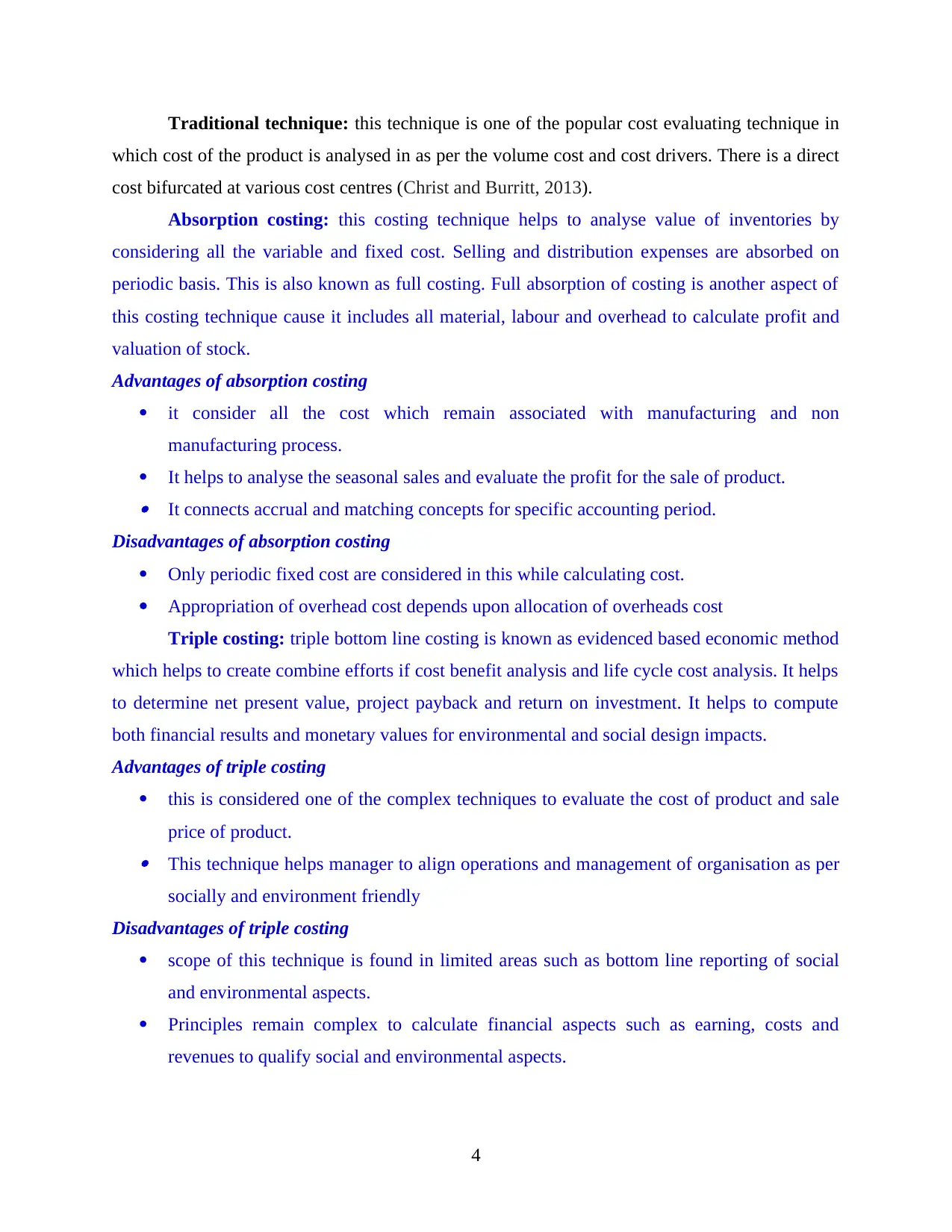
Traditional technique: this technique is one of the popular cost evaluating technique in
which cost of the product is analysed in as per the volume cost and cost drivers. There is a direct
cost bifurcated at various cost centres (Christ and Burritt, 2013).
Absorption costing: this costing technique helps to analyse value of inventories by
considering all the variable and fixed cost. Selling and distribution expenses are absorbed on
periodic basis. This is also known as full costing. Full absorption of costing is another aspect of
this costing technique cause it includes all material, labour and overhead to calculate profit and
valuation of stock.
Advantages of absorption costing
it consider all the cost which remain associated with manufacturing and non
manufacturing process.
It helps to analyse the seasonal sales and evaluate the profit for the sale of product. It connects accrual and matching concepts for specific accounting period.
Disadvantages of absorption costing
Only periodic fixed cost are considered in this while calculating cost.
Appropriation of overhead cost depends upon allocation of overheads cost
Triple costing: triple bottom line costing is known as evidenced based economic method
which helps to create combine efforts if cost benefit analysis and life cycle cost analysis. It helps
to determine net present value, project payback and return on investment. It helps to compute
both financial results and monetary values for environmental and social design impacts.
Advantages of triple costing
this is considered one of the complex techniques to evaluate the cost of product and sale
price of product. This technique helps manager to align operations and management of organisation as per
socially and environment friendly
Disadvantages of triple costing
scope of this technique is found in limited areas such as bottom line reporting of social
and environmental aspects.
Principles remain complex to calculate financial aspects such as earning, costs and
revenues to qualify social and environmental aspects.
4
which cost of the product is analysed in as per the volume cost and cost drivers. There is a direct
cost bifurcated at various cost centres (Christ and Burritt, 2013).
Absorption costing: this costing technique helps to analyse value of inventories by
considering all the variable and fixed cost. Selling and distribution expenses are absorbed on
periodic basis. This is also known as full costing. Full absorption of costing is another aspect of
this costing technique cause it includes all material, labour and overhead to calculate profit and
valuation of stock.
Advantages of absorption costing
it consider all the cost which remain associated with manufacturing and non
manufacturing process.
It helps to analyse the seasonal sales and evaluate the profit for the sale of product. It connects accrual and matching concepts for specific accounting period.
Disadvantages of absorption costing
Only periodic fixed cost are considered in this while calculating cost.
Appropriation of overhead cost depends upon allocation of overheads cost
Triple costing: triple bottom line costing is known as evidenced based economic method
which helps to create combine efforts if cost benefit analysis and life cycle cost analysis. It helps
to determine net present value, project payback and return on investment. It helps to compute
both financial results and monetary values for environmental and social design impacts.
Advantages of triple costing
this is considered one of the complex techniques to evaluate the cost of product and sale
price of product. This technique helps manager to align operations and management of organisation as per
socially and environment friendly
Disadvantages of triple costing
scope of this technique is found in limited areas such as bottom line reporting of social
and environmental aspects.
Principles remain complex to calculate financial aspects such as earning, costs and
revenues to qualify social and environmental aspects.
4
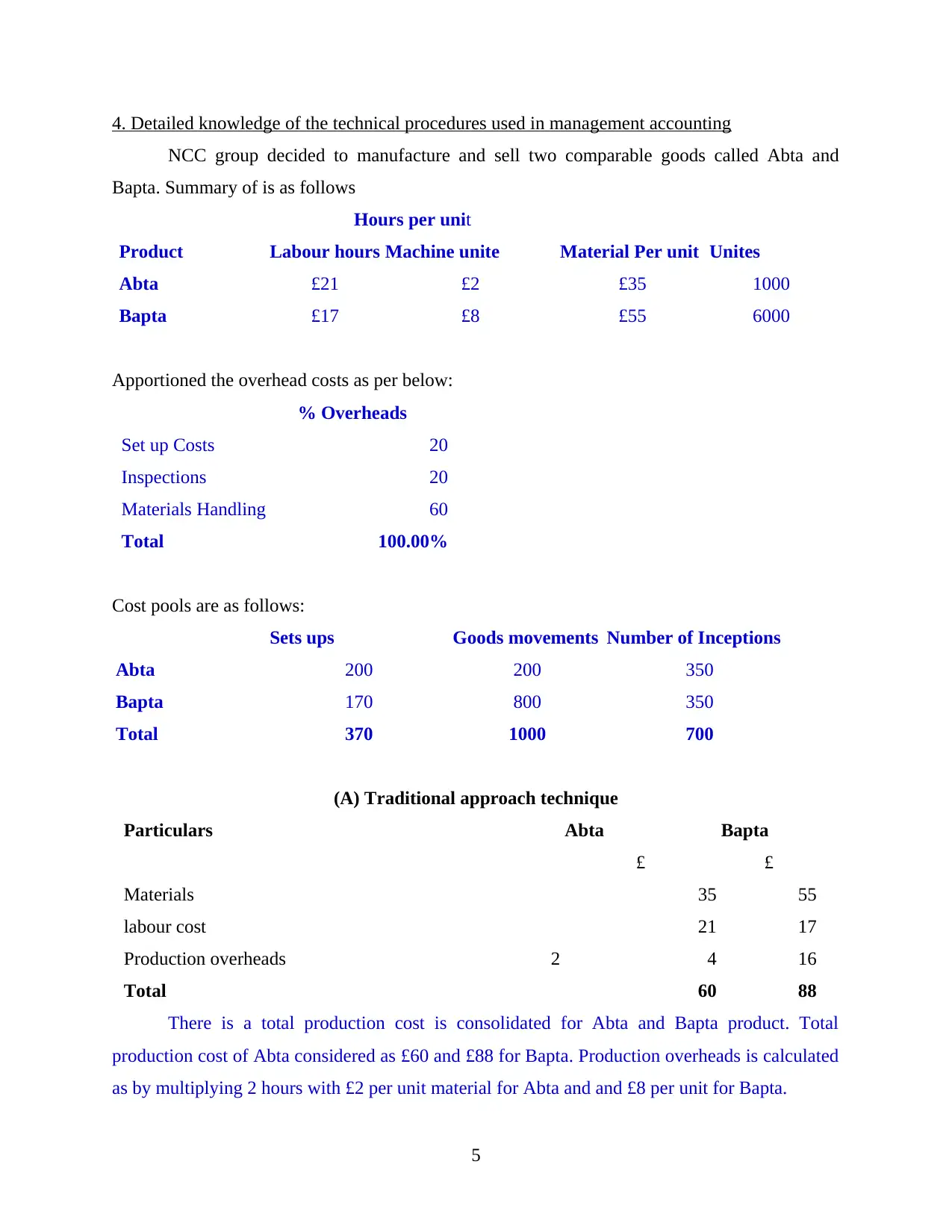
4. Detailed knowledge of the technical procedures used in management accounting
NCC group decided to manufacture and sell two comparable goods called Abta and
Bapta. Summary of is as follows
Hours per unit
Product Labour hours Machine unite Material Per unit Unites
Abta £21 £2 £35 1000
Bapta £17 £8 £55 6000
Apportioned the overhead costs as per below:
% Overheads
Set up Costs 20
Inspections 20
Materials Handling 60
Total 100.00%
Cost pools are as follows:
Sets ups Goods movements Number of Inceptions
Abta 200 200 350
Bapta 170 800 350
Total 370 1000 700
(A) Traditional approach technique
Particulars Abta Bapta
£ £
Materials 35 55
labour cost 21 17
Production overheads 2 4 16
Total 60 88
There is a total production cost is consolidated for Abta and Bapta product. Total
production cost of Abta considered as £60 and £88 for Bapta. Production overheads is calculated
as by multiplying 2 hours with £2 per unit material for Abta and and £8 per unit for Bapta.
5
NCC group decided to manufacture and sell two comparable goods called Abta and
Bapta. Summary of is as follows
Hours per unit
Product Labour hours Machine unite Material Per unit Unites
Abta £21 £2 £35 1000
Bapta £17 £8 £55 6000
Apportioned the overhead costs as per below:
% Overheads
Set up Costs 20
Inspections 20
Materials Handling 60
Total 100.00%
Cost pools are as follows:
Sets ups Goods movements Number of Inceptions
Abta 200 200 350
Bapta 170 800 350
Total 370 1000 700
(A) Traditional approach technique
Particulars Abta Bapta
£ £
Materials 35 55
labour cost 21 17
Production overheads 2 4 16
Total 60 88
There is a total production cost is consolidated for Abta and Bapta product. Total
production cost of Abta considered as £60 and £88 for Bapta. Production overheads is calculated
as by multiplying 2 hours with £2 per unit material for Abta and and £8 per unit for Bapta.
5
Paraphrase This Document
Need a fresh take? Get an instant paraphrase of this document with our AI Paraphraser
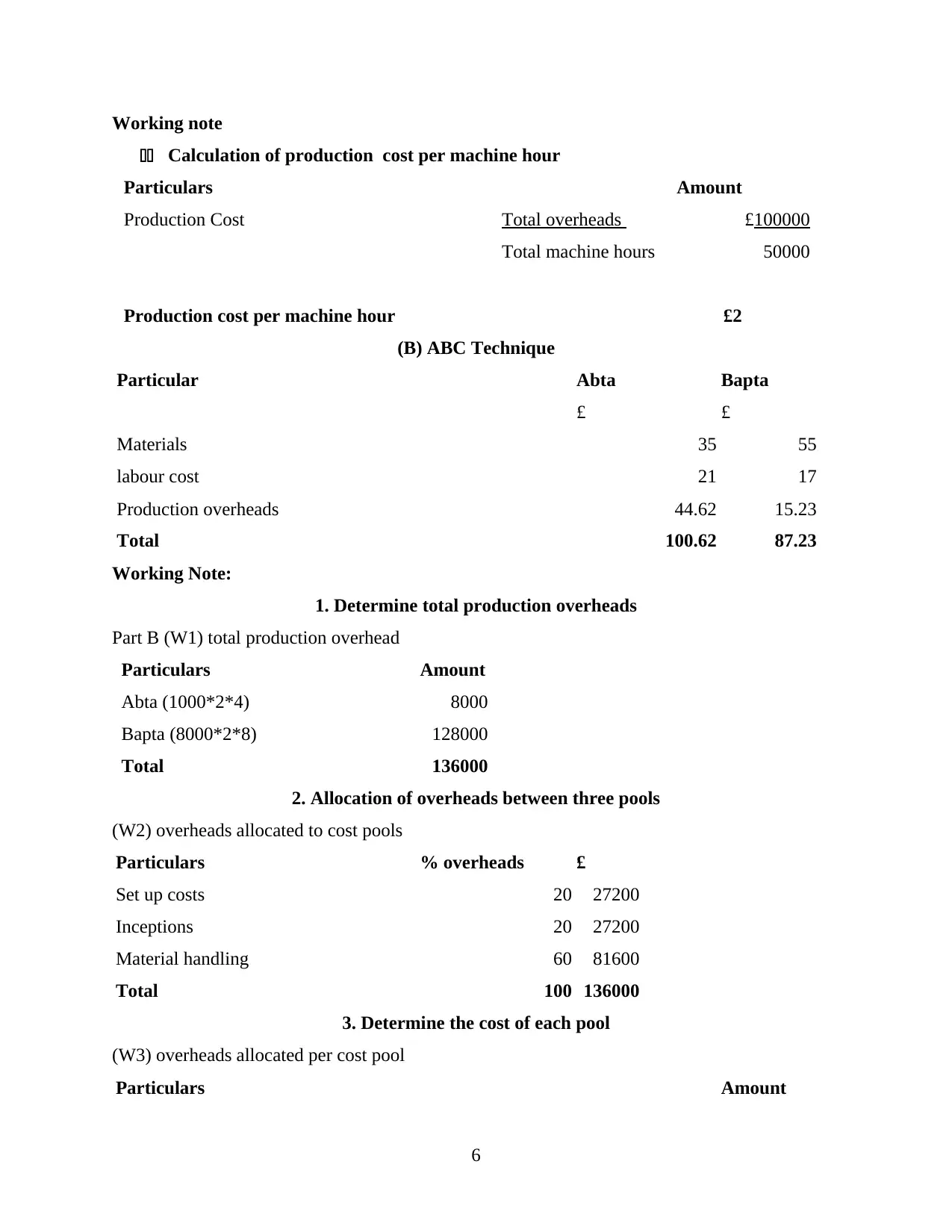
Working note
11 Calculation of production cost per machine hour
Particulars Amount
Production Cost Total overheads £100000
Total machine hours 50000
Production cost per machine hour £2
(B) ABC Technique
Particular Abta Bapta
£ £
Materials 35 55
labour cost 21 17
Production overheads 44.62 15.23
Total 100.62 87.23
Working Note:
1. Determine total production overheads
Part B (W1) total production overhead
Particulars Amount
Abta (1000*2*4) 8000
Bapta (8000*2*8) 128000
Total 136000
2. Allocation of overheads between three pools
(W2) overheads allocated to cost pools
Particulars % overheads £
Set up costs 20 27200
Inceptions 20 27200
Material handling 60 81600
Total 100 136000
3. Determine the cost of each pool
(W3) overheads allocated per cost pool
Particulars Amount
6
11 Calculation of production cost per machine hour
Particulars Amount
Production Cost Total overheads £100000
Total machine hours 50000
Production cost per machine hour £2
(B) ABC Technique
Particular Abta Bapta
£ £
Materials 35 55
labour cost 21 17
Production overheads 44.62 15.23
Total 100.62 87.23
Working Note:
1. Determine total production overheads
Part B (W1) total production overhead
Particulars Amount
Abta (1000*2*4) 8000
Bapta (8000*2*8) 128000
Total 136000
2. Allocation of overheads between three pools
(W2) overheads allocated to cost pools
Particulars % overheads £
Set up costs 20 27200
Inceptions 20 27200
Material handling 60 81600
Total 100 136000
3. Determine the cost of each pool
(W3) overheads allocated per cost pool
Particulars Amount
6
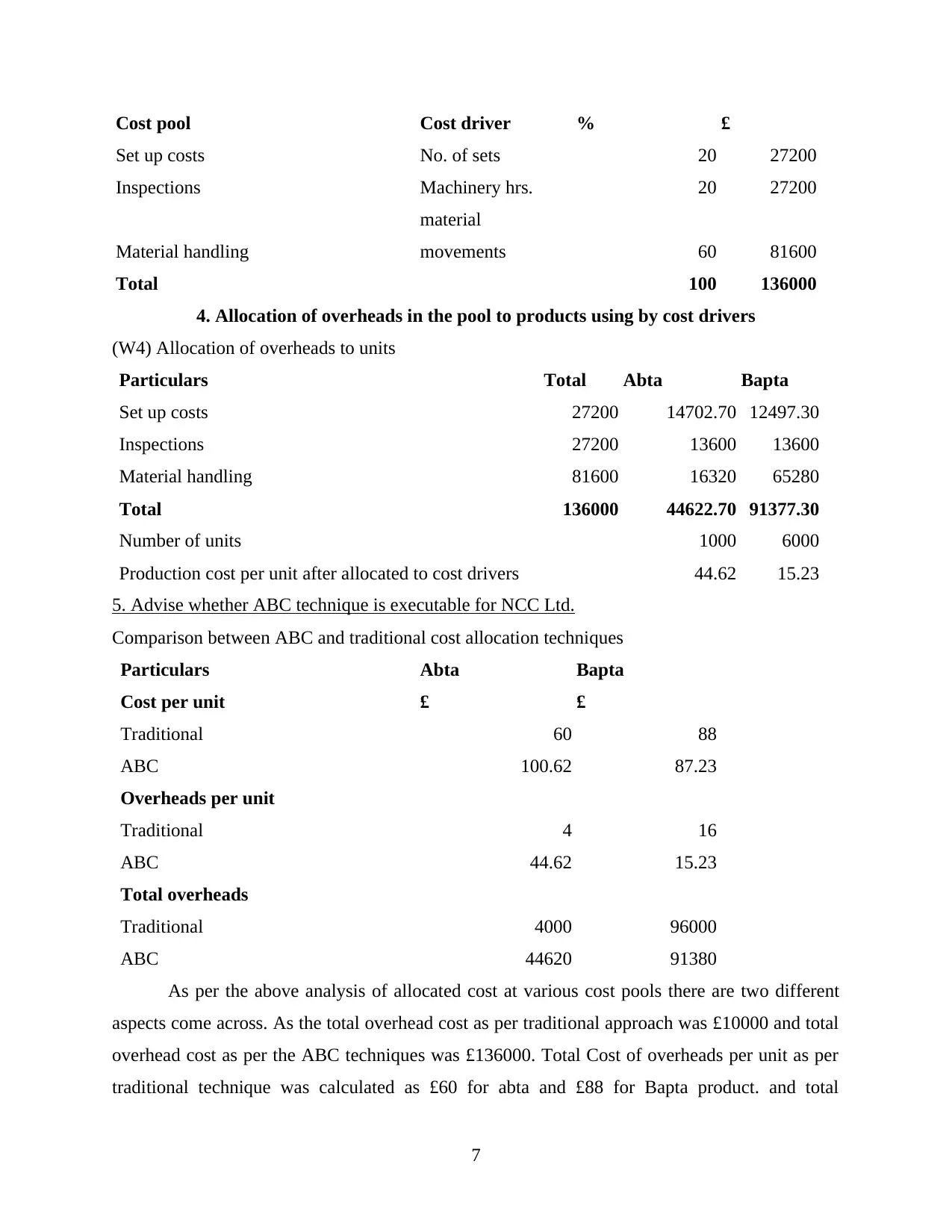
Cost pool Cost driver % £
Set up costs No. of sets 20 27200
Inspections Machinery hrs. 20 27200
Material handling
material
movements 60 81600
Total 100 136000
4. Allocation of overheads in the pool to products using by cost drivers
(W4) Allocation of overheads to units
Particulars Total Abta Bapta
Set up costs 27200 14702.70 12497.30
Inspections 27200 13600 13600
Material handling 81600 16320 65280
Total 136000 44622.70 91377.30
Number of units 1000 6000
Production cost per unit after allocated to cost drivers 44.62 15.23
5. Advise whether ABC technique is executable for NCC Ltd.
Comparison between ABC and traditional cost allocation techniques
Particulars Abta Bapta
Cost per unit £ £
Traditional 60 88
ABC 100.62 87.23
Overheads per unit
Traditional 4 16
ABC 44.62 15.23
Total overheads
Traditional 4000 96000
ABC 44620 91380
As per the above analysis of allocated cost at various cost pools there are two different
aspects come across. As the total overhead cost as per traditional approach was £10000 and total
overhead cost as per the ABC techniques was £136000. Total Cost of overheads per unit as per
traditional technique was calculated as £60 for abta and £88 for Bapta product. and total
7
Set up costs No. of sets 20 27200
Inspections Machinery hrs. 20 27200
Material handling
material
movements 60 81600
Total 100 136000
4. Allocation of overheads in the pool to products using by cost drivers
(W4) Allocation of overheads to units
Particulars Total Abta Bapta
Set up costs 27200 14702.70 12497.30
Inspections 27200 13600 13600
Material handling 81600 16320 65280
Total 136000 44622.70 91377.30
Number of units 1000 6000
Production cost per unit after allocated to cost drivers 44.62 15.23
5. Advise whether ABC technique is executable for NCC Ltd.
Comparison between ABC and traditional cost allocation techniques
Particulars Abta Bapta
Cost per unit £ £
Traditional 60 88
ABC 100.62 87.23
Overheads per unit
Traditional 4 16
ABC 44.62 15.23
Total overheads
Traditional 4000 96000
ABC 44620 91380
As per the above analysis of allocated cost at various cost pools there are two different
aspects come across. As the total overhead cost as per traditional approach was £10000 and total
overhead cost as per the ABC techniques was £136000. Total Cost of overheads per unit as per
traditional technique was calculated as £60 for abta and £88 for Bapta product. and total
7
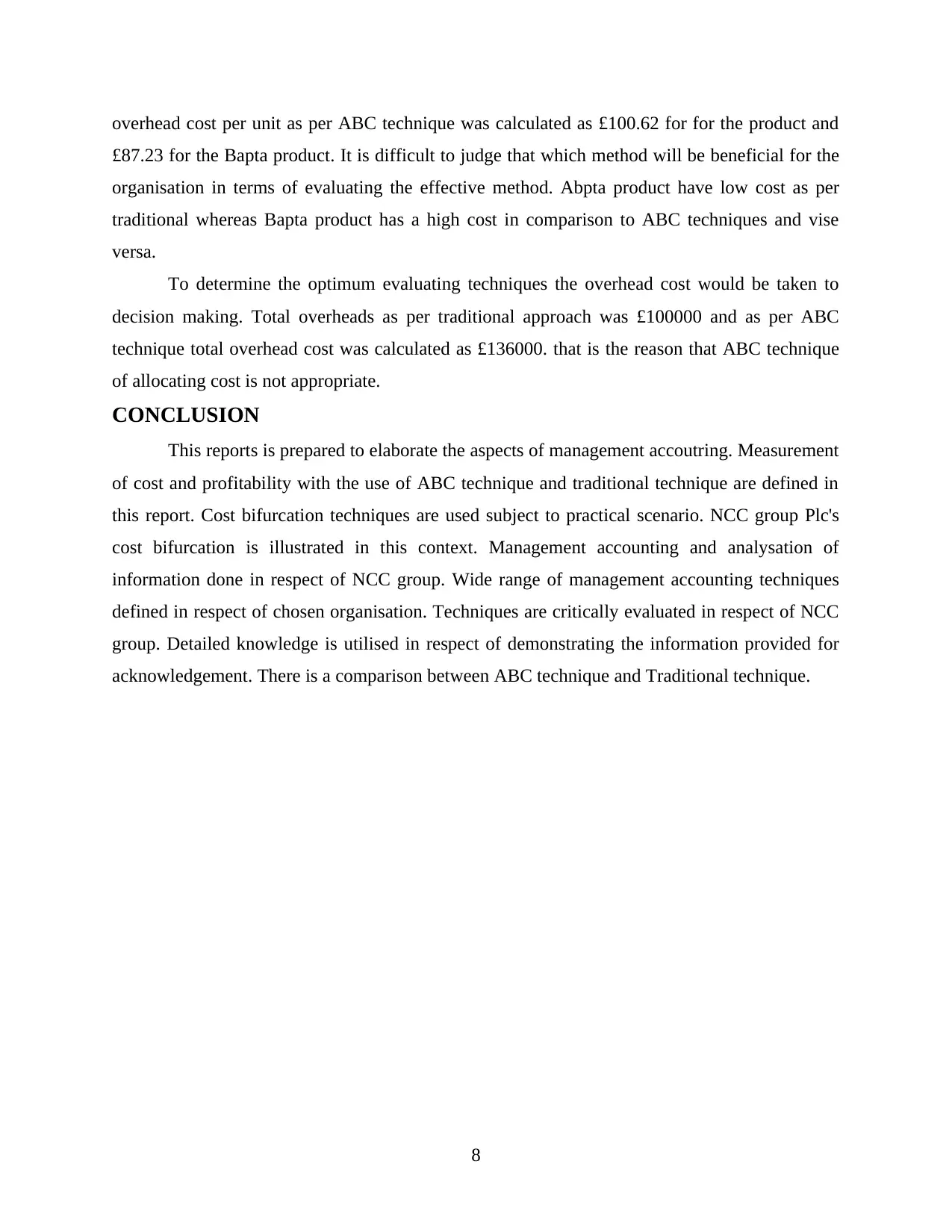
overhead cost per unit as per ABC technique was calculated as £100.62 for for the product and
£87.23 for the Bapta product. It is difficult to judge that which method will be beneficial for the
organisation in terms of evaluating the effective method. Abpta product have low cost as per
traditional whereas Bapta product has a high cost in comparison to ABC techniques and vise
versa.
To determine the optimum evaluating techniques the overhead cost would be taken to
decision making. Total overheads as per traditional approach was £100000 and as per ABC
technique total overhead cost was calculated as £136000. that is the reason that ABC technique
of allocating cost is not appropriate.
CONCLUSION
This reports is prepared to elaborate the aspects of management accoutring. Measurement
of cost and profitability with the use of ABC technique and traditional technique are defined in
this report. Cost bifurcation techniques are used subject to practical scenario. NCC group Plc's
cost bifurcation is illustrated in this context. Management accounting and analysation of
information done in respect of NCC group. Wide range of management accounting techniques
defined in respect of chosen organisation. Techniques are critically evaluated in respect of NCC
group. Detailed knowledge is utilised in respect of demonstrating the information provided for
acknowledgement. There is a comparison between ABC technique and Traditional technique.
8
£87.23 for the Bapta product. It is difficult to judge that which method will be beneficial for the
organisation in terms of evaluating the effective method. Abpta product have low cost as per
traditional whereas Bapta product has a high cost in comparison to ABC techniques and vise
versa.
To determine the optimum evaluating techniques the overhead cost would be taken to
decision making. Total overheads as per traditional approach was £100000 and as per ABC
technique total overhead cost was calculated as £136000. that is the reason that ABC technique
of allocating cost is not appropriate.
CONCLUSION
This reports is prepared to elaborate the aspects of management accoutring. Measurement
of cost and profitability with the use of ABC technique and traditional technique are defined in
this report. Cost bifurcation techniques are used subject to practical scenario. NCC group Plc's
cost bifurcation is illustrated in this context. Management accounting and analysation of
information done in respect of NCC group. Wide range of management accounting techniques
defined in respect of chosen organisation. Techniques are critically evaluated in respect of NCC
group. Detailed knowledge is utilised in respect of demonstrating the information provided for
acknowledgement. There is a comparison between ABC technique and Traditional technique.
8
1 out of 10
Related Documents
Your All-in-One AI-Powered Toolkit for Academic Success.
+13062052269
info@desklib.com
Available 24*7 on WhatsApp / Email
![[object Object]](/_next/static/media/star-bottom.7253800d.svg)
Unlock your academic potential
© 2024 | Zucol Services PVT LTD | All rights reserved.




